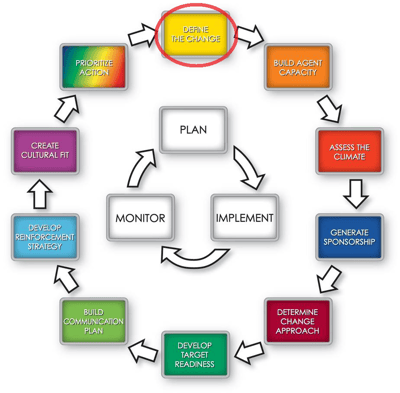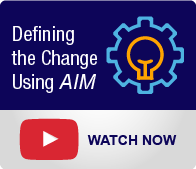“Let’s start at the very beginning. A very good place to start.” While the well-known song lyric is about teaching a group of children to sing, the sage advice also applies to implementing strategic business or clinical initiatives. 
Whether your project is minor or transformational in complexity, you must start with a clear, compelling definition of the change. A well-defined vision of exactly what people will be doing differently at the end of the change, compared to what they are doing today is, in fact, a very good place to start. It’s why Defining the Change is the first step in the Accelerating Implementation Methodology (AIM).
The Sub-Optimization Culprit: The Human Objectives
A project begins with the creation of a project team whose first task is to come to an agreement on the scope of the project and to set project goals. Most project teams we see in our change management consulting work are very good at setting objectives for the timeline, the budget and the technical objectives for the project. These three metrics are, of course, very important to define, but in order to get to the end goal of full value realization, they are not enough.
What is often missed is a commonly-held definition of the business and human objectives for the change. In our change management training classes, we always discuss the 5 metrics that must be met in order to achieve value realization:
- On Time
- On Budget
- Technical Objectives Met
- Business Objectives Met
- Human Objectives Met
The human objectives are the behaviors you seek to see in the future when the change is implemented successfully. Remember, there is no change unless people change their behavior. So, the change definition must address all 5 success measures in order to build organizational alignment around the project and the new behaviors you seek to see.
How to Define the Human Behaviors
To ensure the human objectives are properly defined with rigor and discipline, you should identify the behavior gap between the current state and the future state. These 3 questions should be answered:
- What are we changing? - This question defines where you are moving from (the current state) and what you are moving to (the future state). Most importantly, it answers what success will look like when you get there. Without clarity, you can’t know what resource load will be required to achieve your future state objectives.
- Why are we changing? - This is the business reason for the change. The first questions people want to know about a change is, “What’s in it for me?” (the WIIFM) and “What does this change mean to me in my job?” These questions are not just for the “front line.” In fact, your Sponsors need answers to these questions for their own personal situation or they will remain acting like Targets rather than Sponsors!
- What happens if we don’t succeed? - The answer to this question defines in business AND human terms the downsides or risks of not changing.
The definition of the change must also be translated into the Frames of Reference for the various Target groups, using examples and vocabulary that are meaningful to that group. Too often, the wording of change definitions is based on what resonates for the senior leaders, not the local level audiences. In other words, there is not just one change definition! These definitions must then be clearly communicated to anyone impacted by the change in the form of an elevator speech that ensures consistency.
A Checklist for Change Definition Success
How do you know when you’ve properly defined the change? Here’s a checklist to ensure your definition will be effective:
- A clear and compelling business case for change exists, addressing what, why, consequences of not changing, the WIIFM, and how success will be measured
- The business case has been clearly communicated to all impacted by the change

- All Targets of the change know how to get additional concerns/questions answered
- Behavioral objectives are established and commonly understood
- Success measures are spelled out
- Leadership agrees with all the above
The AIM Change Management methodology is an integrated system of practical strategies, tactics, tools and measurement diagnostics all based around 10 core elements of change. While we say the steps in the process are not linear and are applied in a fit-for-purpose manner, there is one exception. Defining the Change is at the very beginning of the road map, and is most definitely a very good place to start.


